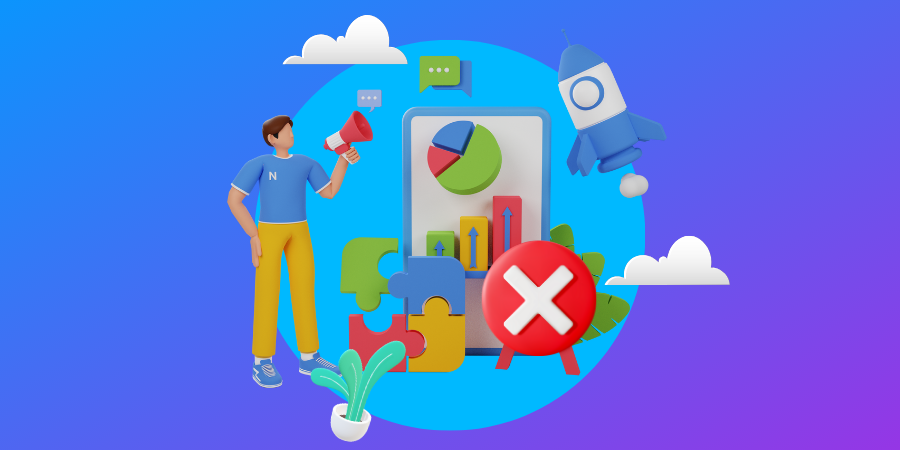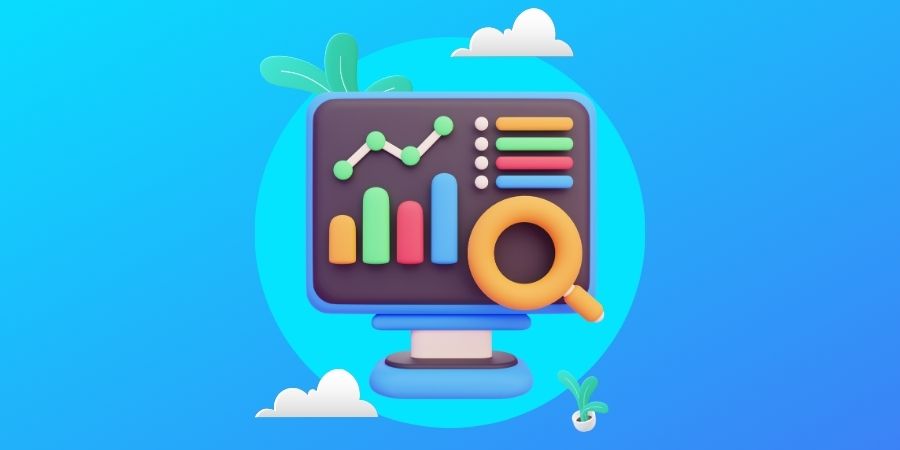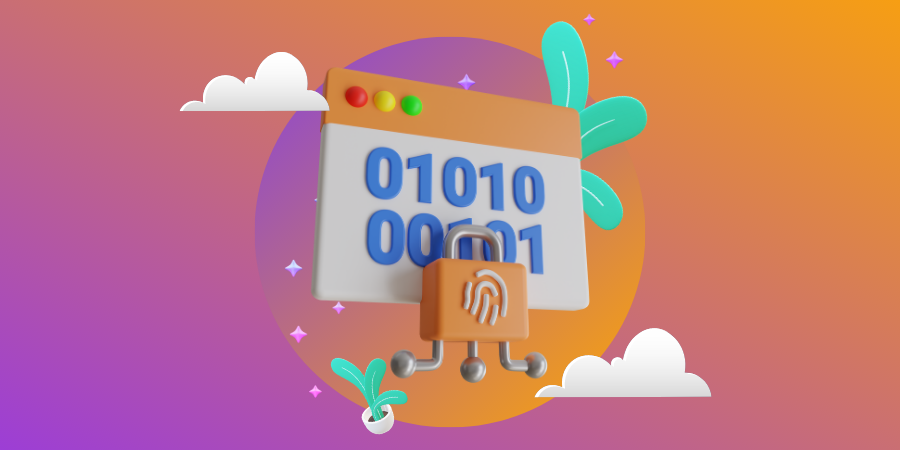As many as 34% of businesses do not consider their marketing successful.
Ad hoc campaigns, inconsistent performance tracking, thin reporting — these are just some of the reasons why campaigns fail.
How do pros ensure marketing success?
They always start their projects with a digital marketing strategy.
In this article, we will show you what a digital strategy is and how it works so you can maximize the payoff for every dollar you invest.
So, let’s dive right in.
Work with our digital marketing experts. Request a quote
What Is A Digital Marketing Strategy?
A digital marketing strategy is a roadmap for all of your digital marketing activities. It helps you select and manage digital channels and enables you to plan campaigns aligned with your overall business goals.
A digital marketing strategy defines:
- Who you advertise to (your target audience)
- Why you advertise (your marketing goals)
- Where you advertise (tactics and channels you use)
- How you measure success (metrics and KPIs you track)
All in all, a digital marketing strategy is an overview of how you will reach and engage more prospects, capture more qualified leads, attract new customers and retain existing ones.
Digital Marketing Strategy vs. Tactics vs. Campaigns: What Are The Differences?
Still scratching your head? Here is a complete explanation:
A digital marketing strategy is the broadest term among these three. It serves as an overview of all your marketing activities, including your goals, the tactics you will use, the channels you will promote your brand on, the processes you will apply, the metrics you will track, your overall budget and more.
Digital marketing tactics include marketing types, techniques and channels you can use for your campaigns. These may include social media marketing (such as Facebook or Instagram ads), email marketing, pay-per-click (PPC) advertising, affiliate marketing, referral marketing, influencer marketing, SEO, content marketing and others.
Digital marketing campaigns are promotional activities you create for a specific offer, discount, new product launch, new collection, product features, services, etc. Each campaign includes its own details such as an allocated budget, channel, duration, goal(s) and key performance indicators (KPIs).
For example, let’s say you run a SaaS business and you want to promote the 2.0 version of your software to your existing customers, but you also want to attract new users and increase the number of free trial subscriptions.
To achieve this, you might decide to:
- Create a promotional email sequence to inform your existing subscribers how they can benefit from the new version
- Write a tutorial to explain how the new features work and how users can migrate to 2.0 without losing existing data — publish it on your blog or as a guest post on a relevant site
- Start advertising campaigns on Facebook, Instagram and LinkedIn to increase brand awareness and attract more people to try your software
Would you be able to do this without a strategy? Yes, but having it all documented and outlined in a strategy helps you save time, make your brand image consistent and keep your team members, executives and stakeholders on the same page.
What Are The Types Of Digital Marketing Strategies?
Now that we’ve made the difference between strategy, tactics and campaigns clear, let’s take a look at what types of digital marketing strategies exist.
As we mentioned, your strategy will depend on your business type, industry, audience, goals and other factors, but your activities can be focused on:
- Single-channel marketing
- Multi-channel marketing
- Omnichannel marketing
How are they different?
Single-channel marketing refers to digital marketing activities focused on only one channel, whether it’s paid search ads, email marketing, Instagram advertising, referral marketing, Facebook ads, influencer marketing or any other channel.
Multi-channel marketing refers to activities across multiple marketing channels such as Google Ads, social media marketing, affiliate marketing and other channels relevant for your business.
Omnichannel marketing refers to using multiple channels with a high level of personalization to provide a seamless customer experience at every touchpoint, including your website, social media, email, chatbot, remarketing and other channels.
How do you know which one is the best for your business?
It will depend on your business and marketing goals, but here are some possible examples:
- If your target audience is C-level executives of tech companies, you might decide to advertise only on LinkedIn. You’d create a single-channel strategy focusing on LinkedIn, including the budget, publishing plan, specific campaign goals and timeframes, InMail outreach tactics, thought-leadership content tactics, etc.
- If you own a make-up brand, you might want to advertise on Instagram and YouTube and include influencer marketing and affiliate marketing tactics. So, you’d create a multi-channel strategy to define specific details for each of the channels and tactics, including the audience, type of promotions, budget attribution and performance evaluation.
- If your customers typically use multiple devices and digital channels and they expect a personalized approach at every point of interaction with your brand, you can create an omnichannel strategy to use different channels to place the right message in front of your audience, through each step of the buyer journey.
What Does A Digital Marketing Strategy Look Like?
It’s time to address various questions you might be asking:
- How to actually create a digital marketing strategy?
- What period of time should it cover?
- What should it include?
- How should you structure it?
- Who should be involved in its creation?
- How can you execute it?
Answers to these questions will mostly depend on your business needs and goals.
For example, if you’re just starting out and you want to raise brand awareness, you can create a strategy to cover the first year of advertising on social media and Google Ads, then revisit your goals to outline a three-year strategy that includes email marketing, affiliates and influencers.
The best practice is to involve your marketing executives and other relevant team members from your company to make sure every aspect is covered – from research and budget to operational workflow and data analytics.
Now, let’s go through the fundamental sections in your strategy outline.
1. Target Audience: Who You Advertise To
Knowing who you want to advertise to is essential for creating an effective digital marketing strategy.
Perform audience research, including focus groups, surveys, one-on-one interviews, social media polls and other methods to identify buyer personas, map out buyer journeys and create insightful conversion funnels.
The best practice is to include:
- Demographic data (age, gender, location, income, marital status, etc.)
- Transactional data (purchases, returns, subscriptions, donations, payments, etc.)
- Behavioral data (online or in-store shopping, mobile or desktop devices, etc.)
- Psychographic data (activities, interests, opinions, habits, behaviors, values, etc.)
Once you have a clearly defined target audience, you’ll have a better overview of your customers’ needs, goals, expectations and preferences, as well as the social platforms they spend most of their time on.
This will help you choose your marketing channels and personalize marketing messages.
2. Marketing Goals: Why You Advertise
The next step is to define the goals you want to accomplish with your digital marketing campaigns.
What are the reasons behind your advertising decisions?
Here, you can use a proven goal-setting framework to set SMART goals.
SMART stands for:
- Specific: Too broad or too vaguely defined goals can lead to undesired outcomes
- Measurable: Define your success and use key performance indicators (KPIs) to track results
- Attainable: Break your big goal into smaller goals and make sure each of them is achievable
- Relevant: Only aim at achieving goals relevant, important and valuable to your brand
- Time-Bound: Set a clear timeframe for each goal and be sure it’s reasonable
Remember: Your marketing goals should align with your overall business goals to help you grow your brand online. So, be sure to check your business plan, brand strategy and communication strategy to see if they complement each other and, if needed, adjust your marketing strategy.
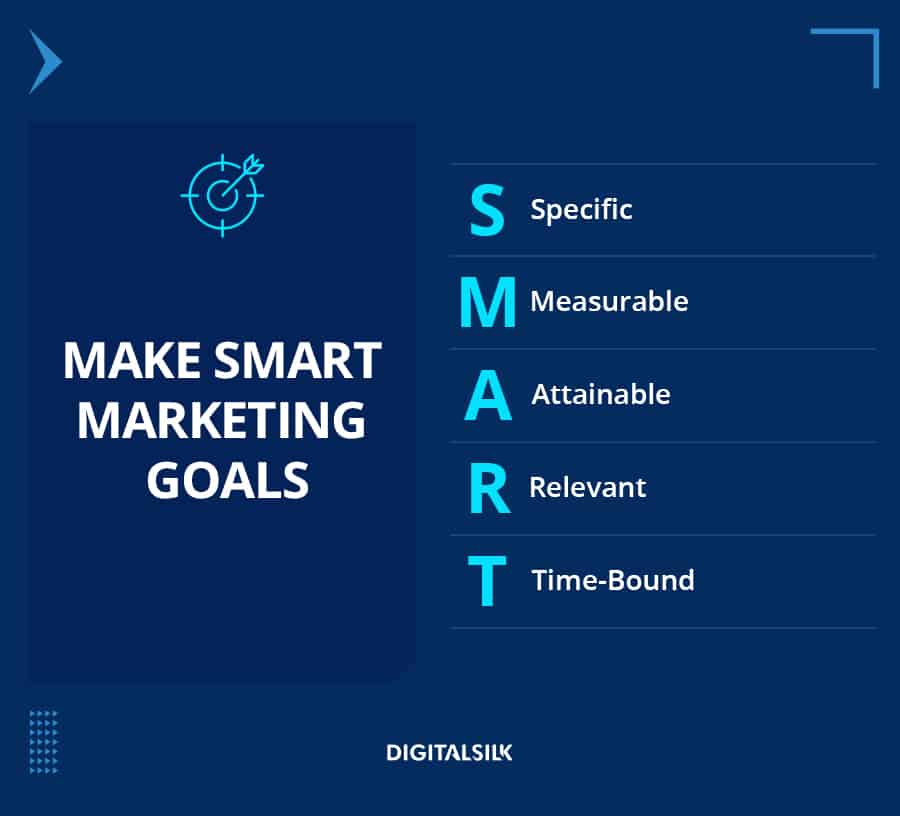
3. Channels & Tactics: Where & How You Advertise
Depending on your target audience, business type, industry and goals, you can choose digital marketing tactics, techniques, platforms and channels that fit your brand the best.
The pool of digital marketing types, tactics and channels include:
- Social media marketing
- Pay-per-click advertising
- Email marketing
- Content marketing
- Search engine optimization (SEO)
- Influencer marketing
- Affiliate marketing
- Referral marketing
- Remarketing
This section of your strategy can also include all the digital tools and software solutions you will use for marketing automation, personalization, customer retention, email and messaging, as well as for online and offline campaign integration.
To make it easier to combine different tactics and channels, keep in mind that there’s a difference between earned, paid and owned media:
- Owned media: Your website, blog, mobile apps, social media presence, etc.
- Paid media: Paid search and display ads, paid social media ads, affiliate marketing, etc.
- Earned media: Partner publishers, influencer outreach, referral marketing, etc.
Here, you can use the popular RACE framework to integrate different tactics and channels into your strategy and optimize performance.
RACE stands for:
- Reach: Use different techniques to reach as many potential customers as possible
- Act: Use calls to action (CTAs) strategically to attract more qualified leads
- Convert: Optimize your campaigns to increase conversion rates
- Engage: Start nurturing long-term relationships to increase customer retention
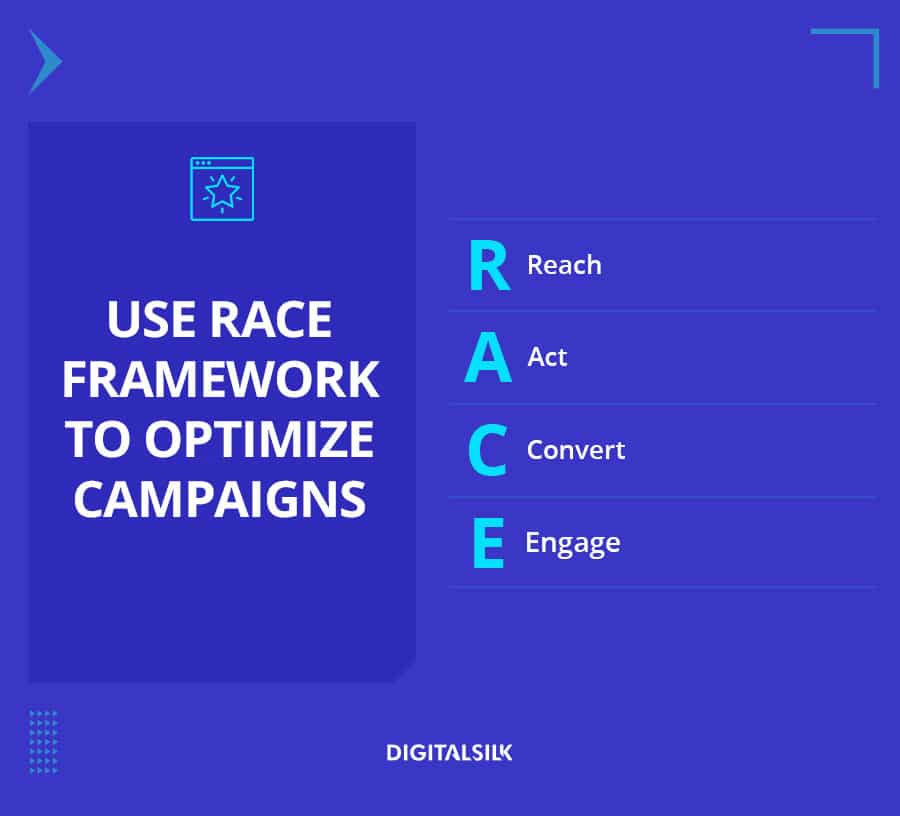
4. Metrics & KPIs: How You Measure Success
First, define what success means for each of your strategic goals.
Then, you can track and analyze results using Google Analytics, Facebook Pixel, Instagram Insights, Google Ads, HubSpot, Buffer, Hootsuite, SEO tools and other solutions to get insights about likes, shares, referring links, audience demographics, points of interaction and more.
Social media tools can also be helpful for social listening and monitoring to let you know when, where, how and how often your brand is mentioned across platforms.
Insights will help you track performance, measure results and evaluate your success.
Here, you can use Google’s HEART framework. Google created it to measure user experience for web applications, but nevertheless, you can adjust the framework to measure the level of audience engagement, find weak points and evaluate your progress.
HEART stands for:
- Happiness: You can use this metric to evaluate overall customer satisfaction
- Engagement: Use this to measure your audience response to your campaigns
- Adoption: This can help you track brand awareness and manage your reputation
- Retention: You can use this metric to measure customer loyalty and retention
- Task Success: You can adjust this metric to track KPIs for each of the campaign goals
The purpose of marketing performance tracking is to identify the channels, tactics and techniques that can bring you the biggest return on investment (ROI) and tweak your strategy to get even more traction in the future.
To help you feel less overwhelmed with all of these sections, we created a digital marketing strategy template to help you get started. You can download it for free right here.
What Are The Typical Digital Marketing Strategy Goals?
The goals of your digital marketing strategy will depend on your business type. So, if you are an online publisher, you’d want to see more website traffic, along with more time spent on a page and on the overall site. And if you run a B2B or B2C company, you’d ultimately want to see more sales.
There are many different goals you can strive to accomplish with your digital marketing efforts and they may include:
- Increased brand awareness
- Targeted website traffic
- Increased conversion rates
- Customer loyalty
- Customer retention
- Brand advocacy across channels
- Increased revenue
To be more specific, here’s an example of digital marketing strategy goals for a B2B company:
- Steady revenue growth with a 20% year-over-year rate in the next five years
- The number of email subscribers grown from 1,000 to 10,000 within a year
- To double email click-through rates (CTR) in the next six months
- Organic website traffic to outgrow Google Ads traffic within the next two years
- Positioning the CEO as an industry thought leader on LinkedIn over the next year
As you can see, strategy goals are typically long-term goals.
But each of your campaigns will have its unique goals to accomplish and KPIs to track.
For example, the goals of your social media campaigns may be to:
- Increase brand awareness
- Increase audience engagement
- Increase brand credibility
Here’s a real-life example.
An AI-based platform for advanced image analysis called Eyecue Insights found that in June 2020, during the Black Lives Matter protests, models with dark skin tones appeared in almost 25% of beauty brand images on social media, but that number dropped to 16% after only two months.
Consumers can see through superficial commitment. In fact, 63% of Americans said it isn’t enough for brands to just issue a statement in support of racial equity — they need to follow up with concrete action.
So, when you start making your marketing strategy, be sure to plan solid campaigns with meaningful actions to support what you stand for.
This also means that flexibility should be incorporated into your marketing strategy because you never know what events might suddenly shift your focus. If 2020 has taught us anything, it is to expect the unexpected.
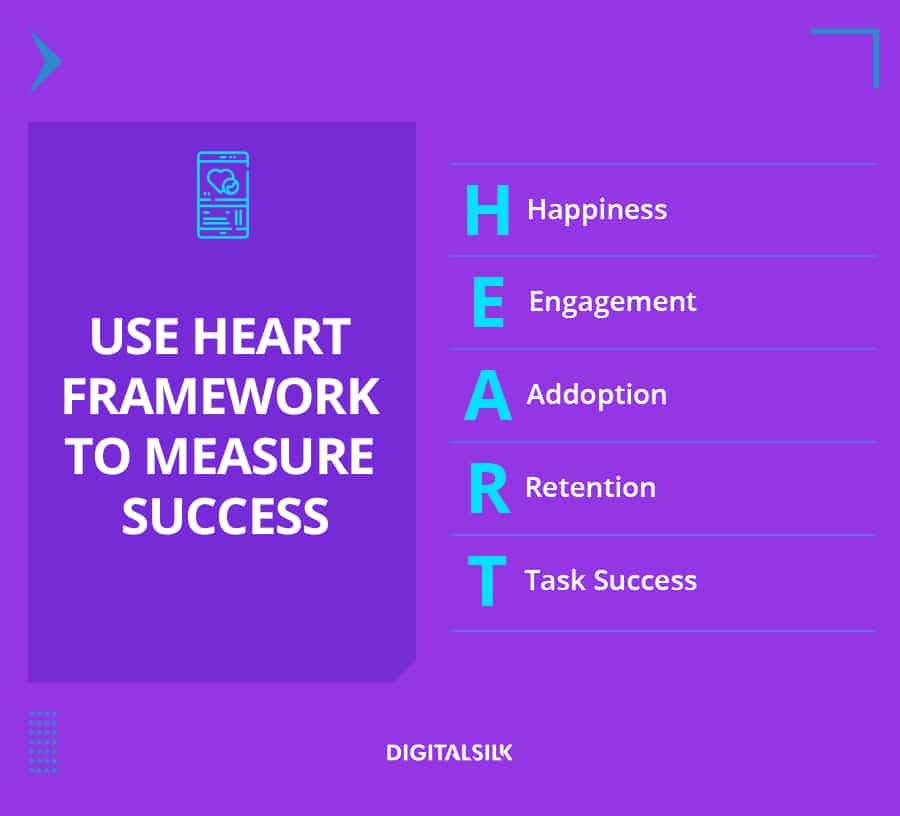
What Are The Key Digital Marketing Strategy KPIs?
How you measure success and evaluate progress is one of the most important parts of your digital marketing strategy.
This is where key performance indicators (KPIs) come in.
For each of your marketing goals, you need to set clear parameters that you will track. This means you can have strategy KPIs, but also campaign KPIs for each of your advertising campaigns.
For example, strategy and/or campaign KPIs may be:
- Revenue that you gain on each of the channels (sales made directly on your website and through referrals, affiliates, Instagram Check-Out, etc.)
- Email opening rates and click-through rates with growth over time
- Organic website traffic metrics in Google Analytics compared to traffic coming from Google display and search ads
- Organic website traffic coming from branded keywords (brand name, product name, etc.)
- The number of likes, shares and comments on your Facebook Ads and other social media campaigns
- The percentage of people who engage with your ads compared to the number of people who saw your ads (actions compared to impressions)
- The relevance of comments (whether your ads are encouraging conversations related to your brand or your offer, whether the comments are mostly positive or negative, etc.)
- The number of website visits coming directly from the links in your social campaigns
It’s important that you define a clear flow for each KPI.
- You can do it by answering these questions:
- To which goal is this KPI related?
- Who is responsible for tracking it?
- Where should they track it?
- What are the benchmarks?
- How often should progress be reviewed?
- How should it be reported and to whom?
How To Get Started
If you are still not sure how to start and what to include in your digital marketing strategy, here’s an overview of steps needed to create a strategy outline:
- Know your target audience: The more you learn about your audience through research, the more effective your strategy will be
- Set clear marketing goals: Define the reasons behind your activities and set clear goals and expectations for everyone on your team
- Choose your channels: Make well-informed, data-backed decisions for tactics and channels you will use for your campaigns
- Measure your progress: Define what KPIs you will track, how you will track them and how you will monitor the results to identify channels that bring the biggest return on investment
Bonus tip: Competitor analysis is also an important part of your strategy. Knowing where your competitors are advertising and how successful their campaigns are can help you find a sweet spot to position your brand and stand out.
Digital Marketing Strategy Takeaways
A digital marketing strategy is a document that gathers all your marketing operations in one place.
It defines your target audience, marketing goals, tactics and channels you will use and metrics you will track to measure your progress and success.
Why should you create it?
An effective digital marketing strategy can help you plan your campaigns aiming to:
- Increase brand credibility and awareness
- Reach and engage more prospects
- Attract more qualified leads
- Gain new customers
- Build a strong online community
- Manage your online reputation
- Grow customer satisfaction and loyalty
- Increase customer retention
- Drive more sales and grow revenue
To accomplish your goals, you can use single-channel, multi-channel or omnichannel marketing, as well as various tactics, techniques and platforms.
All in all, documenting a digital marketing strategy can help you learn more about your audience, create efficient conversion funnels, set short-term and long-term marketing goals and align them with your business and branding goals.
Once you have a strategy, you can start managing content creation by making editorial and social media calendars and analyzing relevant data for your campaigns.
"*" indicates required fields






